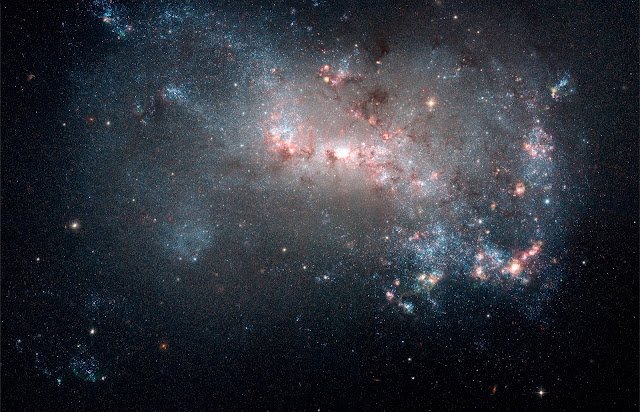Nearly 12.5 million light-years away in the dwarf galaxy NGC 4449 a veritable stellar "fireworks" is on display - here shown in exquisite detail through the eyes of the Hubble Space Telescope.
Hundreds of thousands of vibrant blue and red stars are visible in this image of galaxy NGC 4449 taken by the NASA/ESA Hubble Space Telescope. Hot bluish white clusters of massive stars are scattered throughout the galaxy, interspersed with numerous dustier reddish regions of current star formation. Massive dark clouds of gas and dust are silhouetted against the flaming starlight.
NGC 4449 has been forming stars since several billion years ago, but currently it is experiencing a star formation event at a much higher rate than in the past. This unusual explosive and intense star formation activity qualifies as a starburst. At the current rate, the gas supply that feeds the stellar production would only last for another billion years or so.
Starbursts usually occur in the central regions of galaxies, but NGC 4449 has a more widespread star formation activity, since the very youngest stars are observed both in the nucleus and in streams surrounding the galaxy.
A "global" starburst like NGC 4449 resembles primordial star forming galaxies which grew by merging with and accreting smaller stellar systems. Since NGC 4449 is close enough to be observed in great detail, it is the ideal laboratory for the investigation of what may have occurred during galactic formation and evolution in the early Universe.
It's likely that the current widespread starburst was triggered by interaction or merging with a smaller companion. NGC 4449 belongs to a group of galaxies in the constellation Canes Venatici, the Hunting Dogs. Astronomers think that NGC 4449's star formation has been influenced by interactions with several of its neighbours.
This image was taken in November 2005 by an international science team led by Alessandra Aloisi of European Space Agency (ESA)/the Space Telescope Science Institute (STScI) in Baltimore. Other team members include Francesca Annibali (STScI), Claus Leitherer (STScI), Jennifer Mack (STScI), Marco Sirianni (ESA/STScI), Monica Tosi (INAF-OAB), and Roeland van der Marel (STScI).
Hubble's Advanced Camera for Surveys observed the NGC 4449 in blue, visible, infrared, and Hydrogen-alpha light.
Image Credit: NASA, ESA, A. Aloisi (ESA/STScI) and The Hubble Heritage (STScI/AURA)-ESA/Hubble Collaboration
Explanation from: https://www.spacetelescope.org/news/heic0711/


 About
About Tags
Tags Popular
Popular









0 komentar:
Posting Komentar